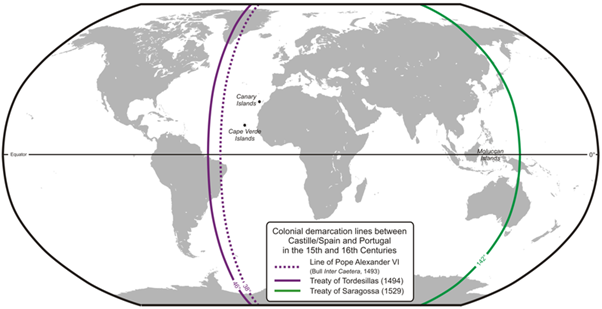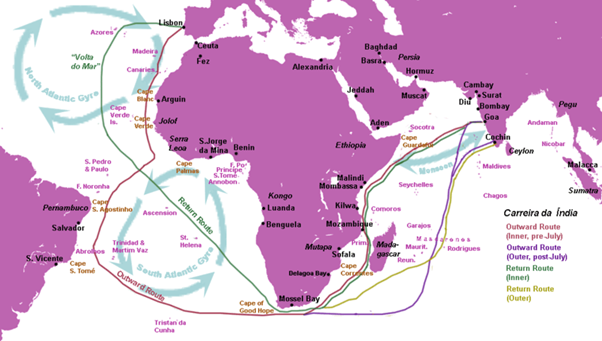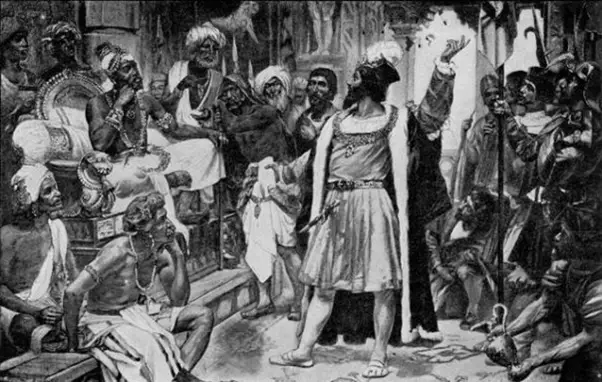 asco da Gama was the first European to set up a maritime trade route to India. In an impressive journey, he sailed along the African coast, beyond the Cape of Good Hope and managed to destroy the monopoly of Arab and Venetian merchants in the spice trade which was considered a luxury in that period of time. Thus, as Shane Winser of the Royal Geographical Society of the United Kingdom explains, Vasco da Gama changed the world. Vasco da Gama’s journey to India is one of the defining moments in the history of great geographical discoveries.
asco da Gama was the first European to set up a maritime trade route to India. In an impressive journey, he sailed along the African coast, beyond the Cape of Good Hope and managed to destroy the monopoly of Arab and Venetian merchants in the spice trade which was considered a luxury in that period of time. Thus, as Shane Winser of the Royal Geographical Society of the United Kingdom explains, Vasco da Gama changed the world. Vasco da Gama’s journey to India is one of the defining moments in the history of great geographical discoveries.
The search for a maritime route to India
In the middle of the fifteenth century, Portugal was the largest maritime power in Europe, thanks to the legacy of Prince Henry the Navigator, who brought to the navigation school in Sagres a talented group of geographers, cartographers, astronomers, and navigators. Henry wanted to find a maritime route to India, thus gaining access to the very profitable spice trade for the country. In addition, he hoped that he would conclude an alliance with the legendary kingdom of Father John with the help of ending Muslim rule in the Indian Ocean business.
For forty years, Henric had sponsored exploration trips along the west coast of Africa, thus laying the foundations for profitable trade in slaves and gold. However, the extreme south of the African continent had remained unknown to Europeans, and the Prince’s dream had never been fulfilled. It was not until 1487 that Bartolomeo Diaz began the journey that would take the Portuguese to the extreme south of Africa. Surrounding the Cape of Good Hope, Diaz demonstrated that there was a connection between the Atlantic Ocean and the Indian Ocean (geographers of the time arguing the exact opposite), and thus reborn the idea that a sea route to India could be discovered.
To complete Diaz’s sea voyage, the Portuguese king John II sent Pedro de Covilha, a good Arabic speaker, on a dangerous journey to India, but following the route on land. Throughout his three-year journey, disguised in Arabic, Covilha obtained valuable information on Muslim ports on the coasts of East Africa and India. But it would be 10 years before the Portuguese could organize a new trip to capitalize on the discoveries of the two. Meanwhile, Columbus, sponsored by the Spaniards, had returned to Europe in 1493, announcing that he had discovered the route to the East across the Atlantic.

At that time, the rivalry between Portugal and Spain for business control with the East intensified. The Pope himself intervened to arbitrate the conflict, and in 1494, after long negotiations, the Treaty of Tordesillas was signed. By this treaty, an imaginary line was drawn north-south (about 1700 kilometers west of Cape Verde) that divided the Atlantic into two: the territories west of this line returned to Spain, and those to the east of Portugal. King John was delighted because he thus kept control of trade on the west coast of Africa and the possible new route to India.
The first maritime trip to India
In 1497, the new king of Portugal, Manuel I, named Vasco da Gama the leader of a new voyage to India. Bartolomeo Diaz personally supervised the preparations for this trip. Da Gama was to lead a fleet of four ships (one of the provisions), two of which were specially built for this occasion.
Vasco da Gama left Lisbon on July 8th, 1497. Bartolomeo Diaz accompanied the group to the Canary Islands, and then to the Cape Verde Islands. For the next stage of the trip, Diaz advised him to go on an unusual route, in the west-south-west direction, across the Atlantic, to avoid the calm area of the Gulf of Guinea. Following this route, the Portuguese reached about 1000 kilometers from the Brazilian coasts before the southwest winds pushed them towards South Africa. On November 7th, they arrived in St. Helena Port, 200 kilometers north of Cape of Good Hope. It had been 13 weeks since the explorers had last seen the dry land, after traveling over 7200 kilometers from Cape Verde.
Two days later, da Gama’s fleet surrounded the Cape of Good Hope and stopped at Mossel Bay. The supply ship was burned, and the supplies were redistributed to the other three ships. The group began their journey north along the east coast of South Africa. Sailing north against a strong current, da Gama’s group traveled 2700 kilometers along the coast, and on March 2nd, 1498, it reached the port of Mozambique, the first in a range of Muslim city-states at the southern end of the area. of Muslim influence in East Africa.
The explorers were not well received by the Sultan; their gifts, considered worthless, were rejected. This is explained by the fact that, despite the massive investments in that expedition, the Portuguese underestimated the quality of the goods in the markets of this world: cotton, ivory, gold, and even pearls. The group continued their journey north, reaching Mombassa, where they were received as badly as before. Only the leader of Malindi was more benevolent than the group of Europeans, and during his stay there, da Gama recruited a very experienced sailor perhaps the famous Arab sailor Ahmen Ibn Majid to show them the route to India.

The explorers crossed the Arabian Sea in 27 days, their journey was facilitated by the favorable winds. Da Gama’s fleet reached Calicut, on the Malabar coast. The area was the center of the spice trade and the main market for Kerala pepper (a very expensive type of pepper). It was also the place where ships from the Moluce Islands came to trade with nails with Arab merchants.
The newcomers stayed in Calicut for three months and were initially well received by the local Hindu leader. But Muslim traders enjoyed some influence in the Court and were not willing to give up control over the trade-in spices in front of Christian visitors. And, once again, the goods that Gama offered for the business were considered inadequate. The relations between the Portuguese and the locals deteriorated, and the people of da Gama made great efforts to gather the necessary goods for the trip back home.
Vasco da Gama returned to Lisbon on September 18, after more than two years, during which time he traveled 38,600 kilometers. Only 54 of the 170 crew survived. However, the king was pleased, thinking that if this expedition could be done once, it could be done again. Beyond the fact that this trip was one of the greatest achievements of the time many historians and even contemporary historians consider this journey much more important than the success of Columbus, crossing the Atlantic, it was the basis of events that changed the world.
Avid Writer with invaluable knowledge of Humanity!
Upcoming historian with over 30 million views online.
“You make your own life.”





